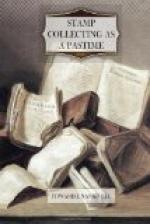Collectors are all familiar with the long series of portraits of past Presidents of the United States, from Washington to Garfield.
The stamps of Don Carlos mark the Carlist rising in Spain in 1873.
But amongst the most interesting of all stamps that may be classed as historical finger posts, none equal in present-day interest the stamps of the Transvaal, for they tell of the struggle for supremacy in South Africa. In 1870 the Boers issued their first postage stamp, and a crude piece of workmanship it was, designed and engraved in Germany. Till 1877 they printed their supplies of postage stamps in their own crude way from the same crude plates. Then came the first British Occupation, when the remainders of the stamps of the first South African Republic were overprinted “V.R. Transvaal,” to indicate British government. Then, in 1878, the stamps of the Republic were replaced by our Queen’s Head. In 1881 the country was given back to the Boers, when they in turn overprinted our Queen’s Head series in Boer currency, to indicate the restoration of Boer domination. And now, finally, in 1900 we have the second British Occupation, and a second overprinting of South African Republic stamps “V.R.I.”, to signalise once more, and finally, the supremacy of British rule in South Africa. The Mafeking stamps are also interesting souvenirs of a gallant stand in the same historical struggle.
The war which Chili some years ago carried into Bolivia and Peru has been marked in a special manner upon the postage stamps of Chili. As in the case of our own troops in South Africa, so the Chilian troops in Bolivia and Peru were allowed to frank their letters home with the stamps of their own country. So also the Chilians further overprinted the stamps of Peru with the Chilian arms during their occupation of the conquered country in the years 1881-2. Chilian stamps used along the route of the conquering army, and postmarked with the names of the towns occupied, are much sought after by specialists. These postmarks include Arica, Callao, Iquique, Lima, Paita, Pisagua, Pisco, Tacna, Yca, etc.
And so the stamp collector may turn over the pages of his stamp album, and point to stamp after stamp that marks, for him, some development of art, some crisis in a country’s progress, some struggle to be free, or some great upheaval amongst rival powers. In fact, every stamp issued by a country is, more or less, a page of its history.
[Illustration:]
[Illustration:]
VII.
Stamps with a History.
There are numbers of stamps that have an interesting history of their own. They mark some official experiment, some curious blunder or accident, some little conceit, some historical event, or some crude and early efforts at stamp production.




